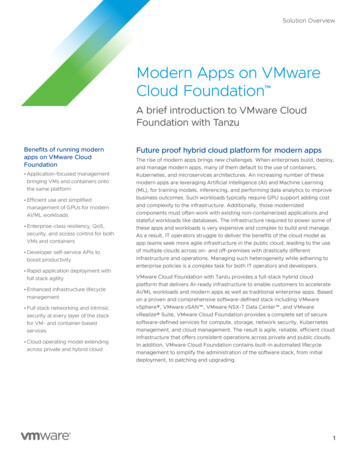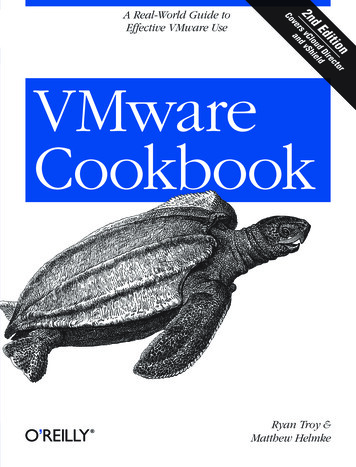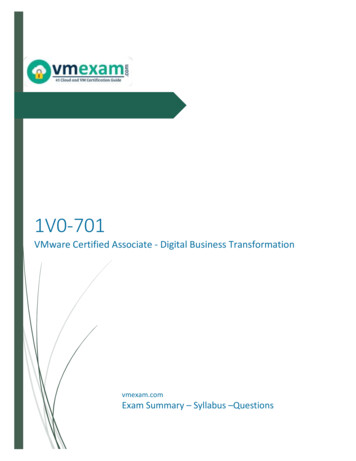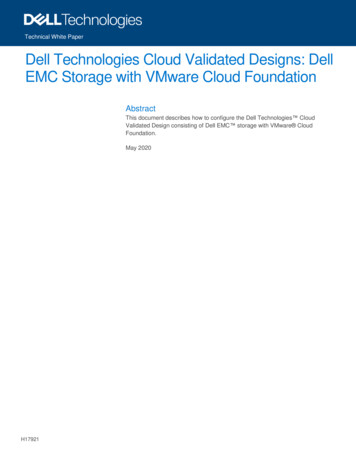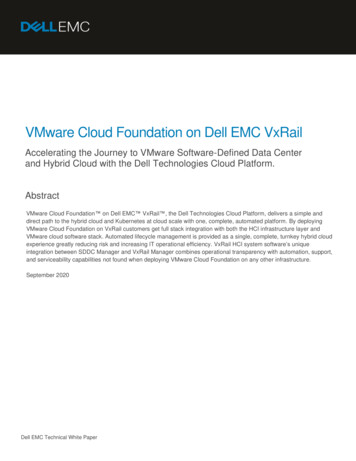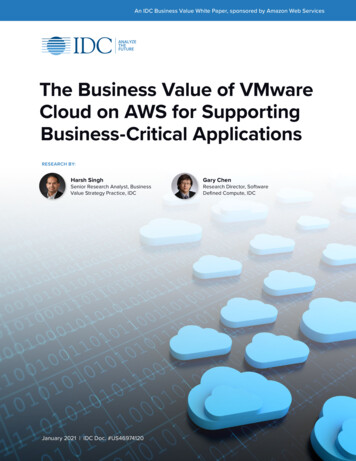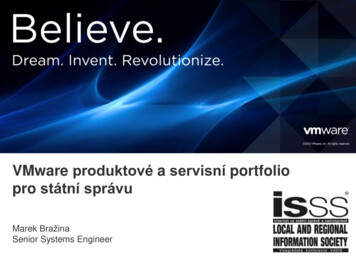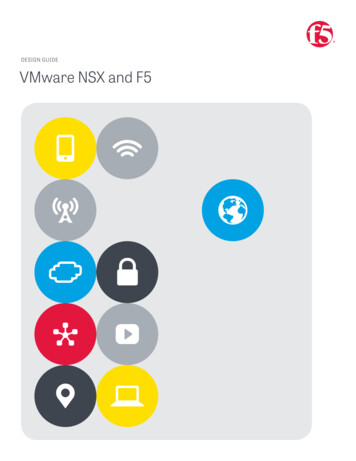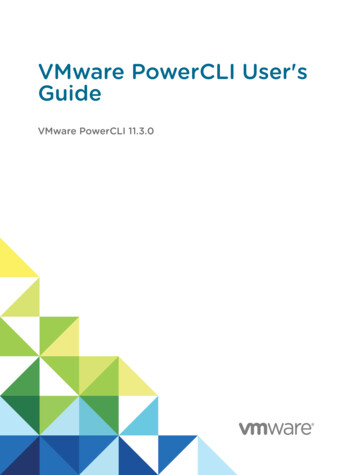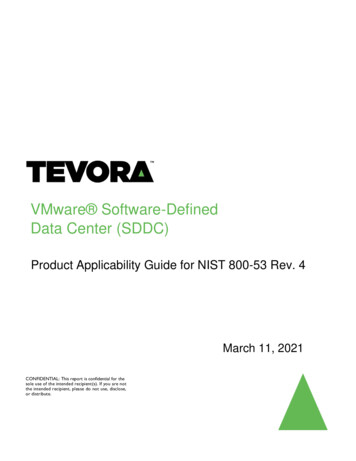
Transcription
VMware Software-DefinedData Center (SDDC)Product Applicability Guide for NIST 800-53 Rev. 4March 11, 2021CONFIDENTIAL: This report is confidential for thesole use of the intended recipient(s). If you are notthe intended recipient, please do not use, disclose,or distribute.
VMware SDDC NIST 800-53 Product Applicability GuideTable of ContentsTable of Contents.2Revision History .3Design Subject Matter Experts.3Trademarks and Other Intellectual Property Notices .4Executive Summary .5Background .5Introduction .7What is NIST 800-53?.7How does NIST 800-53 work?.7Scope and Approach . 9Our Approach .9In-Scope VMware Product List. 12Overview of VMware and NIST 800-53 Best Practices and Requirement Mapping . 15VMware Control Capabilities Detail . 18VMware Administrative Support for NIST Control Families . 19VMware Core Support for NIST Control Families . 20VMware Core Controls . 21VMware Administrative Controls . 37Conclusion . 46Bibliography . 47Appendix A: NIST 800-53 Control Mapping . 48Appendix B: SDDC Product Capability Relationship with NIST 800-53 . 49About VMware . 89About Tevora . 90VMware SDDC NIST 800-53 (Rev. 5) PAG 2
VMware SDDC NIST 800-53 Product Applicability GuideRevision .0TevoraInitial DraftVMwareDesign Subject Matter ExpertsThe following people provided key input into this whitepaper.NameEmail a.comCo-AuthorAnir Desaiadesai@tevora.comCo-AuthorCarlos Phoenixcphoenix1@vmware.comJerry Breaudjbreaud@vmware.comGlobal Cyber Strategist,VMwareDirector, Product Management,Compliance Solutions,VMwareVMware SDDC NIST 800-53 (Rev. 5) PAG 3
VMware SDDC NIST 800-53 Product Applicability GuideTrademarks and Other Intellectual Property NoticesThe VMware products and solutions discussed in this document are protected by U.S. andinternational copyright and intellectual property laws. VMware products are covered by one ormore patents listed at http://www.vmware.com/go/patents. VMware is a registered trademark ortrademark of VMware, Inc. and its subsidiaries in the United States and other jurisdictions. Allother marks and names mentioned herein may be trademarks of their respective companies.Solution AreaKeyProductsSoftware-Defined ComputeVMware ESXi , VMware vCenter ,VMware,VMware vSphere , VMwarevSAN , VMware vCloud DirectorExtender, VMware vCloud Usage MeterSoftware-DefinedNetworkingVMware NSX Management andAutomationDisaster RecoveryAutomationVMware vRealize Network Insight ,VMware vRealize Automation ,VMware vRealize Orchestrator ,VMware vRealize Log Insight ,VMware vRealize OperationsManager , VMware vCloud Director ,VMware AppDefense , Workspace OneAccess VMware Site Recovery Manager ,VMware vSphere Replication , VMwarevCloud Availability for vCloud Director Disclaimer (Tevora)The opinions stated in this guide concerning the applicability of VMware products to the NIST 800 -53framework are the opinions of Tevora. All readers are advised to perform individual product evaluationsbased on organizational needs.For more information about the general approach to compliance solutions, please visit VMwareSolution Exchange: Compliance and Cyber Risk Solutions. This whitepaper has been reviewed andauthored by Tevora’s staff of Information Security Professionals in conjunction with VMware, Inc.Disclaimer (VMware)This document is intended to provide general guidance for organizations that are consideringVMware solutions to help them address compliance requirements. The information contained inthis document is for educational and informational purposes only. This document is not intended toprovide regulatory advice and is provided “AS IS”. VMware makes no claims, promises, orguarantees about the accuracy, completeness, or adequacy of the information contained herein.Organizations should engage appropriate legal, business, technical, and audit expertise within theirspecific organization for review of regulatory compliance requirements.VMware SDDC NIST 800-53 (Rev. 5) PAG 4
VMware SDDC NIST 800-53 Product Applicability GuideExecutive SummaryBackgroundIn this Product Applicability Guide (PAG), we will provide an evaluation of VMware products thatmake up and support the Software-Defined Data Center (SDDC), and how they may support NIST800-53 Rev. 4 (NIST 800-53) controls. These products virtualize and abstract the physicaltechnology layers such as compute, storage, and network, the essence of a SDDC. The changingtechnology landscape that is modernizing the data center is also modernizing the virtual desktopenvironment and mobile device management while making inroads to consolidate and automateInformation Technology (IT) resources. VMware prioritizes data protection and system securityfeatures within the SDDC. The VMware Compliance Solutions team developed a framework thatincorporates SDDC product capabilities aligned to NIST 800-53 controls. Using NIST 800-53 as afoundational risk framework and security control catalog, the framework maps VMware products tocontrol requirements to weave together VMware product capabilities with compliance requirementsand cybersecurity controls.NIST 800-53 provides organizations with a tested baseline of controls. It can be used toestablish and refine a comprehensive data protection and cybersecurity program. Ultimately, therisks an organization faces are mitigated by controls, and the PAG provides one perspective onhow VMware products can assist organizations with managing their cyber risks and implementinga stronger IT security control program.VMware engaged Tevora, an independent third-party IT audit firm, to conduct a review of the SDDCand VMware Cloud solution’s alignment to NIST 800-53. This document is the culmination ofTevora’s discussions with VMware product teams to perform a thorough evaluation of VMwareproduct capabilities mapped to NIST 800-53 controls.Tevora is a leading security consulting firm specializing in enterprise risk, compliance, informationsecurity solutions, and threat research. Tevora offers a comprehensive portfolio of informationsecurity solutions and services to clients in virtually all industries. This PAG will navigate readersthrough the NIST 800-53 standard and highlight applicable VMware product capabilities.VMware SDDC and NIST 800-53Today’s infrastructures are heterogeneous in nature, built upon collaborations between internallyconstructed products and third-party sourced components, all guided by a customer’s complexbusinessand compliance requirements.VMware SDDC NIST 800-53 (Rev. 5) PAG 5
VMware SDDC NIST 800-53 Product Applicability GuideVMware approaches compliance with a view that understands the complexity in environmentsand addresses those areas where virtualization can be leveraged to develop a more secureenvironment. Thisfocused view on compliance is reflected in the VMware Compliance Solutionsframework, which allows fora wide-ranging adoption of regulatory controls.The phrase “security by design” identifies architectural decisions and default settings insideVMware products that are integrated into the product lifecycle. This approach reflects the processVMware follows to weave in security through all stages of the product lifecycle, and not as anafterthought. A compliance-capable design follows the philosophy that mapping SDDC productcapabilities to NIST 800-53 security requirements can result in a solution that has been vettedas compliance capable. This overlap between products and compliance requirementsestablishes a new level marrying security and non-security product capabilities to also achieveoperational innovation. Due to the breadth of the NIST compliance framework, VMware selectedNIST 800-53 as its foundation for all future PAGs and as the acknowledgment across industrystandards that have been derived from the larger NIST risk framework.What is SDDC?The Software-Defined Data Center architecture creates a completely automated, highly availableenvironment for any application, and any hardware. SDDC can be used in any type of cloud model,and extends the existing concepts associated with the cloud such as abstraction, pooling, andvirtualization toall aspects of the cloud environment. Features of the SDDC can be deployed as asuite or can also work independently to allow for a controlled deployment over time.What is NIST?The National Institute of Standards and Technology (NIST) was founded in 1901 and is now part ofthe U.S. Department of Commerce. NIST is one of the nation's oldest physical science laboratories.Today, NIST measurements support the smallest of technologies to the largest and mostcomplex of human-made creations—from nanoscale devices so tiny that tens of thousands can fiton the end of a single human hair, up to earthquake-resistant skyscrapers and globalcommunication networks. NIST also assists the federal government in issuing standards to meetthe provisions and requirements such as the Federal Information Security Management Act(FISMA).VMware SDDC NIST 800-53 (Rev. 5) PAG 6
VMware SDDC NIST 800-53 Product Applicability GuideIntroductionWhat is NIST 800-53?NIST Special Publication (SP) 800-53 Rev. 4 has been developed by NIST to further its statutoryresponsibilities under the Federal Information Security Management Act (FISMA), Public Law (P.L.)107–347. It represents the culmination of a year-long initiative to update the content of the securitycontrols catalog and the guidance for selecting and specifying security controls for federal informationsystems and organizations. The project was conducted as part of the Joint Task ForceTransformation Initiative in cooperation and collaboration with the Department of Defense, theIntelligence Community, the Committee on National Security Systems, and the Department of HomelandSecurity. The proposed changes included in Rev. 4 are directly linked to the current state of the threatspace (i.e., capabilities, intentions, and targeting activities of adversaries) and the attack data collectedand analyzed over a substantial time-period. NIST 800-53 is an extensive catalog of informationsecurity controls.While the initial intent of NIST 800-53 was to provide guidance and criteria for federal informationsystems, revisions have been made over the past few years for widespread adoption across variouscommercial and private industries.The fifth revision draft was released in August 2017 and updates preceding publications within the areas of: Insider Threats Software Application Security(including web applications) Social Networking, Mobile Devices, and CloudComputing Cross-Domain Solutions Advanced Persistent Threats Supply Chain Security Industrial/Process Control Systems PrivacyHow does NIST 800-53 work?The NIST 800-53 standard requires organizations to comply with a robust set of criteria. The criteria arebroken down into 20 control families (listed below) and provided ratings of impact to the business ororganization.Ratings are either Low-Impact, Moderate-Impact, or High-Impact. These risk ratings identify the specificcontrols to be implemented within each control family.VMware SDDC NIST 800-53 (Rev. 5) PAG 7
VMware SDDC NIST 800-53 Product Applicability GuideRatings are either Low-Impact, Moderate-Impact, or High-Impact. These risk ratings identify the specificcontrols to be implemented within each control family. Access Control (AC)Awareness and Training (AT)Audit and Accountability (AU)Assessment and Authorization (CA)Configuration Management (CM)Contingency Planning (CP)Identification and Authentication (IA)Individual Participation (IP)Incident Response (IR)Maintenance (MA) Media Protection (MP) Privacy Authorization (PA)Physical and Environmental Protection (PE)Planning (PL)Program Management (PM)Personnel Security (PS)Risk Assessment (RA)System and Services Acquisition (SA)System and Communications Protection (SC)System and Information IntegrityTo derive the specific risk rating, a “Three-Tiered Risk Management” approach allows organizations astrategic viewpoint, not a solely compliance-based viewpoint, on security program development. Thetiers are used to conclude the applicable risk rating that ultimately results in identifying the specificcontrols within each control family that are applicable. The risk is derived based on the following tieredrisk approach: Tier 1 – Organization Tier 2 – Mission/Business Processes Tier 3 – Information SystemsAll control families may not be applicable to an organization, depending on their size and scope ofbusiness. Each control takes the “Three-Tiered Risk Management” model into account and providessupplemental guidance on what a well-defined control looks like.These controls will aid U.S.-based entities moving forward within a shifting regulatory landscape. Whilethe standard is lengthy, it would be advantageous for any organization to define and/or align theirsecurity program against it, especially those organizations evaluating overseas expansion.VMware SDDC NIST 800-53 (Rev. 5) PAG 8
VMware SDDC NIST 800-53 Product Applicability GuideScope and ApproachThe SDDC and VMware Cloud platform covers a wide number of products and architectures. Theplatformsand each of their component products contain features that could be mapped to someNIST 800-53 controls. Of the 20 total control families, 17 had mapping overlaps to VMwaresoftware capabilities. This guide expands to account for all products underneath the SDDCumbrella. The scope of this guide is limited to those requirements supported either technically orthrough direct API integration. Additional technologies required in addition to VMware products arenot identified. People and process controls are defined as administrative controls, in support ofNIST 800-53 control intents.Our ApproachThis Product Applicability Guide (PAG) is intended to provide information for all security andcompliance practitioners on Tevora’s recommended usage of the VMware technical stack toaddress regulatory compliance obligations and enhance the security of their services throughthe security and compliance framework of NIST 800-53. It is up to each organization to identify theapplicable NIST 800-53 controls and requirements that are in scope and, in addition, to determinethe risk rating of NIST 800-53 High, Moderate, and Low impacts. The PAG focuses on capabilities ofthe SDDC product and VMware Cloud at the control family level, as each organization will need toidentify its control scope based on risk ratings and to performits own risk rating and selection ofcontrols based on the organization’s scope and the relevance to its objectives. Thus, controlsmay vary within control families based on risk ratings. A technical whitepaper, to be released later,will compile information gathered within this PAG and apply to each individual NIST 800- 53 control.Appendix B outlines specific product capabilities for SDDC and VMware Cloud, and their alignmentto NIST 800-53 control families.In addition to the NIST 800-53 control families, we used eleven (11) security lenses that serve as abaseline to evaluate SDDC and VMware Cloud products. From the ground up, VMware strives todesign, define, and deliver compliance solutions to customers. The compliance solution begins witha compliance context (e.g., requirements from the appropriate standards in question). Next, thetechnical requirements applicable to the VMware products are mapped to in-scope compliancerequirements. Finally, an independent audit evaluation of the design is conducted. The output is asolution that has interwoven compliance requirements into the end solution available to customers.Below is an overview of this process.VMware SDDC NIST 800-53 (Rev. 5) PAG 9
VMware SDDC NIST 800-53 Product Applicability GuideExhibit 1: VMware Compliance Solutions Regulatory Controls MappingOutside of the process described above, these eleven (11) areas are broad categories of controlsthat are implemented within today’s security programs. They can be used to further understand thebroader technology concepts used to build security architectures and to implement controls tomitigate risks.The eleven (11) security lensesinclude: Automated Security System Hardening Compliance Validation System Access Data Segmentation System Monitoring Data Encryption & ProtectionNetwork ProtectionEndpoint ProtectionTrusted Execution/Secure BootSoftware Development Lifecycle (SDLC)Evaluating the SDDC and VMware Cloud through the additional layer of security lenses helpssecurity and compliance practitioners understand how products deliver the features required notonly to support compliance with the NIST 800-53 standard but also to comport with general securitybest practices.VMware SDDC NIST 800-53 (Rev. 5) PAG 10
VMware SDDC NIST 800-53 Product Applicability GuideTevora reviewed the high-level product design, followed by a detailed examination of data flows,features, architectures, and capabilities across all in-scope products to identify applicable controls.The testing considered all potential configurations that allow SDDC products to support each requirement.The evaluation produced this guide to provide executives, technology experts, and security andcompliance practitioners with insight to enhance security and compliance postures using VMwareproducts. The SDDC’s flexibility in feature deployment allows for connection with preexistingsystems to further fortify security, privacy, and compliance. Understanding this flexibility is key tothen understanding how VMware products can be deployed with continuous compliance in mind.Exhibit 2: Percentage of SDDC Products that are capable of meeting the NIST 800-53 (Rev. 4) control objectives.VMware SDDC NIST 800-53 (Rev. 5) PAG 11
VMware SDDC NIST 800-53 Product Applicability GuideIn-Scope VMware Product ListSoftware-Defined Data Center (SDDC)VMware ESXi – ESXi is a purpose-built bare-metal hypervisor that installs directly onto a physicalserver. With direct access to and control of underlying resources, ESXi is more efficient than hostedarchitectures and can effectively partition hardware to increase consolidation ratios and cut costsfor our customers.VMware vSAN – vSAN is a core building block for the Software-Defined Data Center, deliveringenterprise-class, flash- optimized, and secure storage for all user’s critical vSphere workloads.Datacenter and Cloud InfrastructureVMware vSphere – vSphere, the industry-leading virtualization platform, provides a powerful,flexible, and secure foundation for business agility that accelerates the digital transformation tocloud computing and success in the digital economy.VMware vCenter – vCenter provides centralized management of vSphere virtual infrastructure.IT administrators can bolster security and availability, simplify day-to-day tasks, and reduce thecomplexity of managing virtual infrastructure.Networking and SecurityVMware AppDefense – AppDefense is a data center endpoint security product that protectsapplications running in virtualized and cloud environments.VMware NSX – NSX-v is the network virtualization and security platform for the Software-DefinedData Center (SDDC), delivering the operational model of a virtual machine for entire networks. WithNSX, network functions including switching, routing, and firewalling are embedded in the hypervisor anddistributed across the environment.VMware NSX -- NSX-T is a network virtualization program which creates, deletes, and restoressoftware-based virtual networks. With network virtualization, the functional equivalent of a networkhypervisor reproduces the complete set of Layer 2 through Layer 7 networking services (for example,switching, routing, access control, firewalling, QoS) in software.VMware SDDC NIST 800-53 (Rev. 5) PAG 12
VMware SDDC NIST 800-53 Product Applicability GuideStorage and AvailabilityVMware Site Recovery Manager – Site Recovery Manager is the industry-leading solution toenable application availability and mobility across sites in private cloud environments. It is anautomation software that integrates with an underlying replication technology to provide policybased management, non-disruptive testing, and automated orchestration of recovery plans. Thisprovides simple and reliable recovery and mobility of virtual machines between sites, with minimalor no downtime.Hyperconverged InfrastructureVMware vSAN – vSAN is a core building block for the Software-Defined Data Center, deliveringenterprise-class, flash- optimized, and secure storage for all user’s critical vSphere workloads.Cloud Management PlatformvRealize SuiteVMware vRealize Operations Manager – vRealize Operations Manager is designed toautomate and simplify the performance, troubleshooting, capacity, cost planning, andconfiguration management of applications and infrastructure across physical, virtual, and cloudenvironments.VMware vRealize Log Insight – vRealize Log Insight delivers heterogeneous and highlyscalable log management with intuitive, actionable dashboards; sophisticated analytics; andbroad, third-party extensibility, providing deep operational visibility and faster troubleshooting.VMware vRealize Network Insight – vRealize Network Insight delivers intelligent operations forsoftware-defined networking and security. It helps customers build an optimized, highly available,and secure network infrastructure across multi-cloud environments. It accelerates microsegmentation planning and deployment, enables visibility across virtual and physical networks,and provides operational views to manage and scale NSX deployments.VMware vRealize Orchestrator – vRealize Orchestrator is a powerful automation tool designedfor system administrators and IT operations staff who must streamline tasks and remediationactions and integrate these functions with third-party IT operations software.VMware vRealize Automation – vRealize Automation empowers IT to accelerate theprovisioning and delivery of IT services across infrastructure, containers, applications, and customservices. Leveraging the extensible framework provided by vRealize Automation, you canstreamline and automate the lifecycle management of IT resources from initial service modeldesign through Day One provisioning and Day Two operations.VMware SDDC NIST 800-53 (Rev. 5) PAG 13
VMware SDDC NIST 800-53 Product Applicability GuidevCloud SuiteVMware vCloud Director –vCloud Director is the VMware flagship Cloud Management Platformfor Cloud Providers. vCloud Director enables Cloud Providers to deliver differentiated cloudservices on their VMware cloud infrastructure and provides enterprises with self-service cloudcapabilities.VMware vCloud Director Extender – vCloud Director Extender provides the ability to connectvCenter environments on- premises to a cloud based on vCloud Director to securely migrate virtualmachines and extend virtual networks to the cloud. vCloud Director Extender provides seamlesshybridity between on-prem and cloud environments based on vSphere.VMware vCloud Usage Meter – vCloud Usage Meter helps Cloud Providers access VMwareresources on a consumption- based monthly subscription, including vCloud Usage Insight, aSaaS tool that provides automated usage reporting, simple onboarding, secure data transfer andaggregation of usage across all contracts and sites.Digital WorkspaceWorkspace ONE -- Workspace ONE is an intelligence-driven digital workspace platform. Itintegrates access control, application management and multi-platform endpoint management into asingle platform.Business ContinuityVMware Site Recovery Manager – Site Recovery Manager is the industry-leading solution toenable application availability and mobility across sites in private cloud environments. It is anautomation software that integrates with an underlying replication technology to provide policybased management, non-disruptive testing, and automated orchestration of recovery plans. Thisprovides simple and reliable recovery and mobility of virtual machines between sites, with minimalor no downtime.VMware vSphere Replication – vSphere Replication is an extension to VMware vCenterServer that provides hypervisor- based virtual machine replication and recovery.VMware vCloud Availability for vCloud Director – vCloud Availability Cloud to Cloud DR providesvSphere native replication of workloads for Disaster Recovery or migration purposes between vCloudDirector Organization Virtual Data Centers. The solution is compatible to the vCloud Director self-serviceuser interface or standalone and features symmetric source or destination execution of replication,migration, failover and failback of workload virtual machines and VMware vSphere vApps withinvCloud Director. Using a consumption model of 10pts per protected virtual machine per month, cloudproviders are able to monetize their infrastructure by driving more breadth in their portfolios by offeringadditional managed or self-service disaster recovery and contingency planning services between cloudinstances on a tiered basis and drive professional service opportunities.VMware SDDC NIST 800-53 (Rev. 5) PAG 14
VMware SDDC NIST 800-53 Product Applicability GuideOverview of VMware and NIST 800-53 BestPractices and Requirement Mapping.Best Practice Area(Lens)Automated SecurityData SegmentationSystem HardeningCompliance ValidationNIST 800-53Automated Deployment,Automated RemediationCP, RAPL, SA, SC, SICM, MP, PS,SA, SC, SICMCapability DescriptionNetwork & Host Firewall,Information FlowConfiguration Management,Patch Management,Vulnerability ManagementConfiguration ManagementVMware ProductApplicabilitySite Recovery ManagervSphere ReplicationvRealize OperationsvCloud DirectorvCloud Availability forvCloud DirectorNSX-vVMware ValidatedDesign vRealizeNetwork InsightvRealize OperationsvRealize Log InsightAppDefensevCloud UsageMetervCloudDirectorvCloud Director ExtendervCloud Availability forvCloud DirectorvRealize NetworkInsight vRealizeOperations vRealizeLog Insight vSphereUpdate ManagerNSX-vESXi 6.7AppDefensevCloud UsageMetervCloudDirectorvCloud Director ExtendervCloud Availability forvCloud DirectorvRealize NetworkInsight vRealizeOperations vRealizeLog InsightNSX-vAppDefensevCloudDirectorVMware SDDC NIST 800-53 (Rev. 5) PAG 15
VMware SDDC NIST 800-53 Product Applicability GuideSystem AccessAC, AT, AU, IA,IR,PE, PL, PS,SCTwo-Factor Authentication,Identity and AccessManagementvCenterNSX-vvRealize Network InsightvRealize Log InsightvRealize OperationsESXi 6.7AppDefensevCloud Usage MetervCloud DirectorvCloud Director ExtendervCloud Availability for vCloudDirectorvRealize Log InsightvRealize Network InsightSystem MonitoringData Encryption& ProtectionAT, AU, CA, CM, CP,IR, MA, PE, PL,PS, RA, SC, SICA, IA, MA, SA,SC, SI, PASecurity InformationEvent Monitoring(SIEM), DatabaseMonitoringData at Rest Encryption,Data in MotionEncryption, SystemBackup & RestoreVMware SDDC NIST 800-53 (Rev. 5) PAG 16vRealize OperationsSite Recovery ManagervSphere ReplicationvCentervSphere UpdateManagerAppDefensevCloud Usage MetervCloud DirectorvCloud Director ExtendervCloud Availability for vCloudDirectorvSphere 6.7 VM Encryption featurevSAN 6.7vSAN Encryption feature VMwarevSphere vMotion encryptionNSX-vvRealize OperationsvRealize Network InsightvRealize Log InsightvSphereVMware Validated DesignvSphere Update ManagerAppDefensevCloud Usage MetervCloud DirectorvCloud
make up and support the Software-Defined Data Center (SDDC), and how they may support NIST 800-53 Rev. 4 (NIST 800-53) controls. These products virtualize and abstract the physical technology layers such as compute, storage, and network, the essence of a SDDC. The changing


